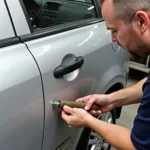Car paint repair instructions can seem daunting, but with the right knowledge and tools, you can achieve professional-looking results. Whether you’re dealing with minor scratches, chips, or more significant damage, this guide will provide you with step-by-step instructions and expert tips to restore your car’s finish.
Understanding the Different Types of Car Paint Damage
Before diving into car paint repair instructions, it’s crucial to identify the type of damage you’re dealing with. This will determine the appropriate repair method and materials. Common types of car paint damage include:
- Scratches: These can range from light clear coat scratches to deep gouges that expose the metal underneath.
- Chips: Small pieces of paint chipped away, often caused by rocks or road debris.
- Scuffs: Superficial damage caused by rubbing against another object, often leaving a mark but not exposing the metal.
- Fading and Oxidation: Sun damage can cause the paint to lose its vibrancy and protective layer.
Knowing the specific issue makes choosing the right car paint repair instructions much simpler.
Gathering the Necessary Tools and Materials
Having the correct tools and materials is essential for successful car paint repair. Here’s a list of commonly used items:
- Cleaning Supplies: Car wash soap, microfiber towels, rubbing alcohol or wax and grease remover.
- Sandpaper: Various grits (e.g., 1500, 2000, 3000) for smoothing the damaged area.
- Masking Tape and Paper: To protect the surrounding undamaged paint.
- Primer (if necessary): For deep scratches that expose the metal.
- Touch-up Paint: Matched to your car’s paint code. Can be a touch up paint pen to repair car paint scratches.
- Clear Coat: To seal and protect the repaired area.
- Polishing Compound: To restore the shine and blend the repair.
- Applicator Pads and Microfiber Cloths: For applying and buffing.
Having everything readily available will streamline the repair process and ensure a smoother outcome.
Step-by-Step Car Paint Repair Instructions for Minor Scratches and Chips
For minor scratches and chips, a car paint chip repair pen kia might be all you need. Here’s a simplified guide:
- Clean the Area: Thoroughly wash and dry the affected area. Use rubbing alcohol or wax and grease remover to ensure a clean surface for proper adhesion.
- Apply Touch-up Paint: Carefully apply the touch-up paint to the chip or scratch, filling it level with the surrounding paint. Less is more. You can always add more later.
- Let it Dry: Allow the touch-up paint to dry completely according to the manufacturer’s instructions.
- Apply Clear Coat (if necessary): If the damage reached the clear coat, apply a thin layer of clear coat over the repaired area.
- Sand and Polish (if necessary): If there are any imperfections after drying, carefully wet sand with fine-grit sandpaper (2000-3000 grit) and then polish to a smooth finish.
This straightforward process is often sufficient for minor blemishes. For more serious damage, see the next section. You might also be interested in learning how to repair deep scratch in car paint.
Repairing Deeper Scratches
Deeper scratches require more involved car paint repair instructions:
- Clean and Prepare: Clean the area thoroughly as described above.
- Sand the Damaged Area: Use a coarser grit sandpaper (e.g., 1500 grit) to smooth the edges of the scratch and remove any loose paint. Gradually move to finer grits for a smoother surface.
- Apply Primer (if necessary): If the scratch reaches the metal, apply a thin coat of primer to prevent rust and provide a better surface for the paint to adhere to.
- Apply Touch-up Paint: Apply thin layers of touch-up paint, allowing each layer to dry before applying the next. Build up the paint until it’s level with the surrounding area.
- Apply Clear Coat: After the touch-up paint has dried, apply a few thin layers of clear coat, allowing each layer to dry completely.
- Sand and Polish: Wet sand with fine-grit sandpaper and polish to a smooth, glossy finish.
 Repairing a Deep Scratch in Car Paint
Repairing a Deep Scratch in Car Paint
Conclusion
Following these car paint repair instructions can help you restore your car’s appearance and protect it from further damage. Remember to choose the right repair method based on the type and severity of the damage. With patience and attention to detail, you can achieve professional-looking results and save money on costly repairs. For specific car paint repair services, you can search for options like “car paint repair baltimore”. Wondering can you use car paint repair on furniture? The answer might surprise you.
FAQ
- How do I find my car’s paint code? The paint code is usually located on a sticker inside the driver’s side doorjamb, glove compartment, or under the hood.
- Can I use nail polish for touch-up paint? While it might seem like a quick fix, nail polish is not formulated for car paint and won’t provide a durable or color-matched repair.
- How long does it take for touch-up paint to dry? Drying time varies depending on the product and environmental conditions, but it’s generally best to wait at least 24 hours before sanding or polishing.
- What if the damage is too extensive for DIY repair? For significant damage, it’s best to consult a professional auto body repair shop.
- How can I prevent future paint damage? Regular washing and waxing, parking in shaded areas, and using a car cover can help protect your car’s paint.
- Can I use household cleaners on my car’s paint? Avoid using harsh household cleaners, as they can damage the clear coat. Stick to car wash soap specifically designed for automotive finishes.
- What if I can’t find a perfect color match for my touch-up paint? Consult a professional auto paint supplier. They can often custom mix a paint that perfectly matches your car’s color.
Need further assistance? Contact us via WhatsApp: +1(641)206-8880 or Email: [email protected]. Our customer service team is available 24/7.

